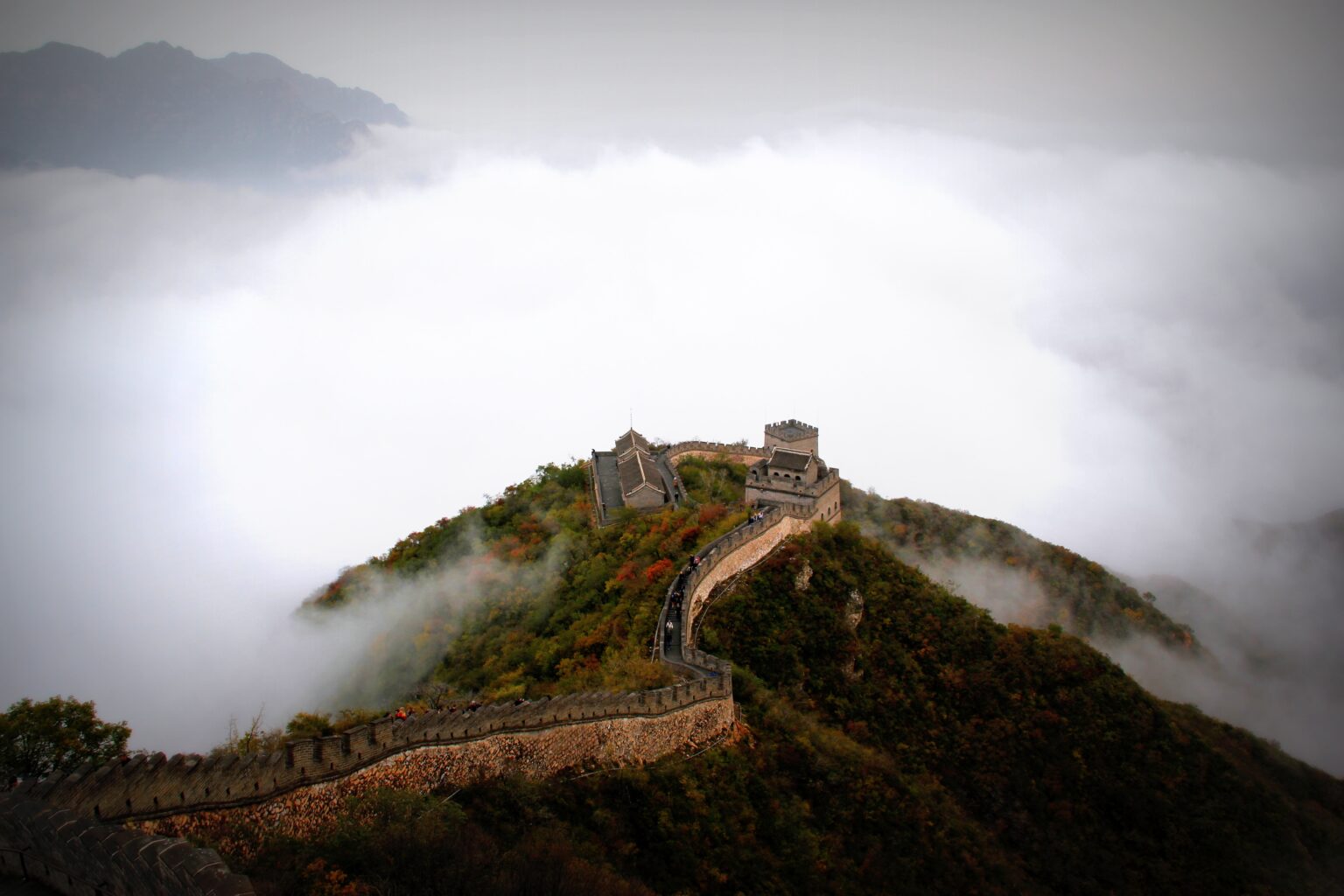Introduction
Exploring the Great Wall of China is a monumental marvel that stands as a testament to human ingenuity, determination, and the enduring spirit of a civilization that spans thousands of years. This iconic structure is not only one of the most recognizable landmarks in the world but also a symbol of China’s rich history and cultural heritage.
Stretching over 13,000 miles (21,196 kilometers) and traversing diverse landscapes, from rugged mountains to vast deserts, the Great Wall is an architectural wonder that has captured the imagination of people around the globe. Its construction began more than two millennia ago, during the 7th century BC, and it continued to evolve and expand throughout various dynasties, with the most famous sections built during the Ming Dynasty (1368-1644 AD).
The primary purpose of the Great Wall was to provide defense against invading forces, serving as a formidable barrier against nomadic tribes from the north. It was a symbol of protection, a boundary between civilization and the wilderness, and a symbol of Chinese strength and resilience.
Today, the Great Wall of China stands as a UNESCO World Heritage Site and attracts millions of visitors each year who come to marvel at its sheer scale and historical significance. It has transcended its original purpose to become a symbol of unity, representing the enduring legacy of the Chinese people and their remarkable ability to accomplish monumental feats of engineering and construction.
In this exploration of the Great Wall, we will delve deeper into its history, architecture, cultural significance, and the awe-inspiring stories that have become intertwined with its ancient stones. Join us on a journey through time and across the vast landscapes of China as we uncover the secrets and wonders of this monumental marvel – the Great Wall of China.
The History of the Great Wall: A Chronicle of Centuries

The story of the Great Wall of China unfolds across the annals of time, revealing a rich tapestry of historical events and dynastic changes. Its origins date back to the Warring States period (476-221 BC), when various Chinese states began constructing walls and fortifications to protect their territories. However, it was during the reign of the first emperor of China, Qin Shi Huang (259-210 BC), that the concept of a unified, continuous Great Wall began to take shape.
Qin Shi Huang is often credited with the initial construction of what would become the Great Wall. His dynasty, the Qin Dynasty, marked the first successful attempt at connecting and fortifying these individual walls into a single defensive structure. The wall served not only as a means of defense but also as a symbol of his authority and control over the newly unified Chinese states.
Subsequent dynasties, such as the Han (206 BC – 220 AD), continued to expand and maintain the Great Wall, extending its reach westward into the Silk Road region and beyond. It was during the Ming Dynasty, however, that the most iconic sections of the Great Wall we recognize today were built. The Ming emperors undertook an ambitious project to rebuild and reinforce the wall, constructing massive stone fortifications, watchtowers, and beacon towers, many of which still stand today.
The Great Wall was not only a physical barrier but also a conduit for cultural exchange. It facilitated trade, communication, and the movement of people, goods, and ideas along the ancient Silk Road. Along its length, travelers and merchants from different cultures left their mark, creating a diverse and vibrant tapestry of history.
Despite its historical significance, the Great Wall faced challenges over the centuries. Parts of it fell into disrepair, and sections were even dismantled for various purposes. However, it remained a symbol of China’s enduring spirit, continually rebuilt and maintained by subsequent dynasties.
In the modern era, the Great Wall of China has garnered international recognition as one of humanity’s greatest architectural achievements. Its historical and cultural significance extends far beyond its original military function, and it serves as a poignant reminder of China’s rich and complex past.
As we continue our journey through the Great Wall’s history, we will explore its remarkable architecture, the legends that surround it, and its enduring cultural impact on China and the world. Join us as we delve deeper into this monumental marvel’s story.
The Magnificent Architecture of the Great Wall

The construction of the Great Wall of China is a testament to ancient engineering prowess and innovation. It is a feat that spans centuries, and its architectural diversity reflects the evolving needs and techniques of the dynasties that built it.
The materials used in the Great Wall’s construction vary depending on the region and era. In the earlier stages, walls were often made of tamped earth, wood, and stone, while later sections, especially during the Ming Dynasty, featured massive stone blocks and bricks. The use of stone not only added to the wall’s strength but also enhanced its aesthetic appeal.
One of the remarkable aspects of the Great Wall is its adaptability to the rugged and diverse terrain it traverses. The wall winds its way through mountains, valleys, and plateaus, following the natural contours of the landscape. This adaptability was achieved through the use of various construction techniques, including stone terracing, earth embankments, and even suspension bridges in some areas.
The Great Wall’s design was not limited to just a continuous barrier. It incorporated an array of defensive features, such as watchtowers, beacon towers, and fortresses, strategically positioned to provide visibility and communication along the wall. These structures served not only as defensive outposts but also as symbols of strength and vigilance. Some watchtowers were equipped with advanced signaling systems, allowing for rapid communication across great distances.
The vastness of the Great Wall allowed for multiple functions beyond defense. It acted as a trade route, connecting China with the outside world. Alongside the wall, small towns and garrisons developed, fostering cultural exchange and the mingling of various ethnic groups.
Throughout its history, the Great Wall has been shrouded in legends and myths. Tales of its construction include stories of toil, sacrifice, and even supernatural forces. The most famous legend is that of Meng Jiangnu, a young woman whose tears are said to have caused a section of the wall to collapse, revealing the bones of her husband, a laborer who died during construction.
Today, the Great Wall of China continues to stand as an enduring symbol of China’s ancient heritage and the indomitable spirit of its people. It remains a source of pride, drawing millions of visitors from around the world who come to witness its grandeur and explore its rich history.
In the following sections of our exploration, we will delve into the cultural significance of the Great Wall, its impact on Chinese identity, and the global fascination it continues to inspire. Join us as we journey deeper into the heart of this monumental marvel.
The Great Wall of China: A Cultural Icon

Beyond its architectural marvels and historical significance, the Great Wall of China holds a special place in the hearts of the Chinese people and has become an integral part of their cultural identity. It symbolizes not only strength and protection but also the enduring spirit of unity and resilience that defines the nation.
For the Chinese, the Great Wall is more than just a physical structure; it is a cultural touchstone that has influenced art, literature, music, and folklore for centuries. It has inspired countless poets, painters, and writers who have celebrated its grandeur and the stories of those who built and defended it.
In traditional Chinese art and literature, the Great Wall often appears as a recurring motif. Poems and paintings depict its majestic towers perched atop rugged mountains, evoking a sense of awe and reverence. The wall has been a source of inspiration for countless artistic masterpieces, capturing the imagination of generations.
Furthermore, the Great Wall has played a pivotal role in shaping the Chinese national identity. It represents the idea of a unified China, a nation that stands strong against external threats. Throughout its history, the wall has been a unifying symbol, bringing together different ethnic groups and regions under the banner of a shared heritage and common defense.
Beyond China’s borders, the Great Wall has become a global symbol of wonder and fascination. It is a destination for travelers seeking to witness the grandeur of ancient history and engineering. Its inclusion as one of the New Seven Wonders of the World further attests to its international renown and appeal.
Preservation efforts in recent decades have sought to safeguard this iconic monument for future generations. UNESCO has designated the Great Wall of China as a World Heritage Site, emphasizing its global cultural significance and the need to protect it.
As we continue our exploration of this monumental marvel, we will delve deeper into the impact of the Great Wall on Chinese culture, its enduring legacy, and the stories of those who built and defended it. Join us as we uncover the layers of history and meaning that make the Great Wall of China an enduring cultural icon.
The Great Wall’s Legacy: A World Heritage Treasure
The legacy of the Great Wall of China extends far beyond its historical significance and cultural symbolism. It is a treasure of global importance, standing as a testament to human ingenuity and the enduring value of preserving our shared heritage.
Preservation and Restoration: Protecting the Great Wall has been a priority for China and the international community. Extensive efforts have gone into restoring and maintaining the wall, ensuring that it continues to stand for future generations to marvel at. Skilled craftsmen and experts work tirelessly to repair sections that have been damaged by time, weather, or human activity, using traditional methods to preserve its authenticity.
UNESCO World Heritage Site: In 1987, UNESCO recognized the Great Wall of China as a World Heritage Site. This designation highlights the global significance of the wall and emphasizes its importance as a cultural and historical treasure that belongs not only to China but to all of humanity. The Great Wall joins a prestigious list of sites that represent the shared heritage of our world.
Tourism and Education: The Great Wall has become a focal point for tourism and education. Millions of visitors from around the world journey to China to explore its wonders, learn about its history, and appreciate its architectural marvels. Museums and educational centers near the wall offer valuable insights into its construction, purpose, and the various dynasties that contributed to its development.
Cultural Exchange: The Great Wall continues to foster cultural exchange and diplomacy. It serves as a platform for international events, festivals, and gatherings that promote friendship and cooperation among nations. It has become a symbol of China’s openness to the world, inviting people of all backgrounds to share in its rich heritage.
Environmental Significance: Beyond its historical and cultural importance, the Great Wall also has ecological significance. It traverses through various ecosystems, contributing to biodiversity and serving as a protective barrier against desertification in some regions. Efforts have been made to balance conservation with tourism to ensure the wall’s environmental sustainability.
In the modern era, the Great Wall of China stands not only as a monument to the past but also as a bridge to the future. Its legacy inspires admiration, fosters cultural exchange, and serves as a reminder of the enduring human spirit. As we conclude our exploration of this monumental marvel, we reflect on the timeless lessons it imparts: the importance of preserving our heritage, the power of unity in the face of challenges, and the boundless possibilities of human achievement. The Great Wall of China remains a treasure for all of humanity, a living testament to the shared history and dreams of people around the world.
Challenges and Conservation: Safeguarding the Great Wall’s Future
While the Great Wall of China has stood for centuries as an awe-inspiring testament to human achievement, it faces numerous challenges in the modern world. Preserving this iconic monument for future generations requires a concerted effort to address these challenges and ensure its continued existence.
Environmental Impact: The Great Wall passes through ecologically sensitive areas, and the influx of tourists can have a negative impact on the environment. Efforts are being made to strike a balance between tourism and environmental preservation, with measures to reduce pollution, control foot traffic, and protect the delicate ecosystems surrounding the wall.
Weathering and Erosion: The Great Wall is exposed to the elements, and natural processes like weathering and erosion take their toll over time. Conservationists employ innovative techniques to mitigate these effects, including the use of protective coatings and carefully managed vegetation.
Urbanization and Development: In some areas, rapid urbanization and development have encroached upon the Great Wall. Conservationists and government authorities must work together to ensure that new construction projects do not compromise the integrity of this ancient monument.
Tourism Management: Managing the influx of tourists is a significant challenge. While tourism brings revenue for conservation efforts, it also poses risks to the wall’s preservation. Implementing sustainable tourism practices, such as limiting visitor numbers and guided tours, is crucial to strike a balance between conservation and accessibility.
Cultural Heritage Protection: Protecting the Great Wall’s cultural heritage goes beyond its physical structure. Ensuring that the stories, legends, and traditions associated with the wall are preserved is equally important. Efforts are made to document and safeguard these intangible aspects of the Great Wall’s legacy.
International Collaboration: The Great Wall’s global significance calls for international collaboration. China actively seeks partnerships with other countries and organizations to share knowledge, expertise, and resources for its preservation. This collaborative approach extends the responsibility of safeguarding this cultural treasure to the international community.
As we confront these challenges, it becomes evident that the Great Wall of China is not just a relic of the past but a living monument that continues to evolve with the times. Its preservation requires a delicate balance between protecting its historical and cultural value while adapting to the needs and realities of the present and future.
Frequently Asked Questions About the Great Wall of China
What is the Great Wall of China?
The Great Wall of China is a massive fortification system made up of walls, watchtowers, and other defensive structures that span thousands of miles across northern China. It was constructed over centuries to protect against invasions from northern nomadic tribes.
How long is the Great Wall of China?
The total length of the Great Wall is approximately 13,000 miles (21,196 kilometers). This measurement includes all the various sections and walls built by different dynasties over time.
When was the Great Wall built?
Construction of the Great Wall began during the 7th century BC, and it continued to evolve and expand through various dynasties, with the most famous sections built during the Ming Dynasty (1368-1644 AD).
Who built the Great Wall?
The Great Wall was built by various Chinese dynasties over centuries, including the Qin, Han, and Ming Dynasties. It involved the labor of soldiers, peasants, and craftsmen who contributed to its construction.
What is the purpose of the Great Wall?
The primary purpose of the Great Wall was defense. It served as a barrier against invasions from the north, protecting China’s borders and territories. Additionally, it facilitated trade, communication, and cultural exchange along the Silk Road.
Can you see the Great Wall from space?
Contrary to popular belief, the Great Wall is not visible from space with the naked eye. It is quite narrow in comparison to the vastness of Earth, and its natural surroundings make it difficult to distinguish from space without specialized equipment.
Which is the most famous section of the Great Wall?
The most famous and frequently visited section of the Great Wall is the Badaling section, located near Beijing. Other well-known sections include Mutianyu and Jinshanling, each offering unique experiences for visitors.
Is the Great Wall open to tourists?
Yes, many sections of the Great Wall are open to tourists. Visitors can explore different parts of the wall, enjoy scenic hikes, and learn about its history and significance through museums and exhibits.
Is the Great Wall in good condition today?
While some sections of the Great Wall have been well-preserved and restored, others have suffered from the effects of time, weather, and human activity. Conservation efforts are ongoing to protect and maintain this cultural treasure.
Is the Great Wall a UNESCO World Heritage Site?
Yes, the Great Wall of China is designated as a UNESCO World Heritage Site, recognizing its global cultural and historical significance.
These frequently asked questions provide an overview of the Great Wall of China, but there is much more to discover about this remarkable monument and its rich history.
Conclusion
The Great Wall of China – An Enduring Marvel
The Great Wall of China, a monumental marvel that spans centuries and miles, continues to capture the world’s imagination and awe. This iconic symbol of China’s history and cultural heritage stands as a testament to human ingenuity, resilience, and the enduring spirit of a civilization that has shaped the course of history.
From its humble beginnings as a collection of regional walls to its transformation into a unified, awe-inspiring fortification, the Great Wall has evolved over time. Dynasties rose and fell, but the wall remained, a constant guardian of China’s northern borders and a source of national pride.
Its architectural diversity, adaptability to rugged terrains, and intricate defensive features reveal the innovative genius of the ancient Chinese builders. The Great Wall not only defended against external threats but also facilitated trade, cultural exchange, and the mingling of diverse peoples along the Silk Road.
Culturally, the Great Wall is a symbol of unity and identity, a source of inspiration for artists and poets, and a testament to China’s openness to the world. UNESCO’s recognition of its global significance underscores its importance as a shared heritage of humanity.
Nevertheless, the Great Wall faces challenges in the modern world, from environmental concerns to managing tourism and development. However, its legacy remains strong, reminding us of the importance of preserving our shared heritage and the enduring value of unity in the face of challenges.
As we conclude our exploration of the Great Wall of China, we are left with a profound appreciation for this iconic monument. It is more than just a wall; it is a bridge to the past, a cultural touchstone, and a symbol of the indomitable human spirit. It is a treasure that belongs not only to China but to all of humanity, a marvel that will continue to inspire wonder and admiration for generations to come.






